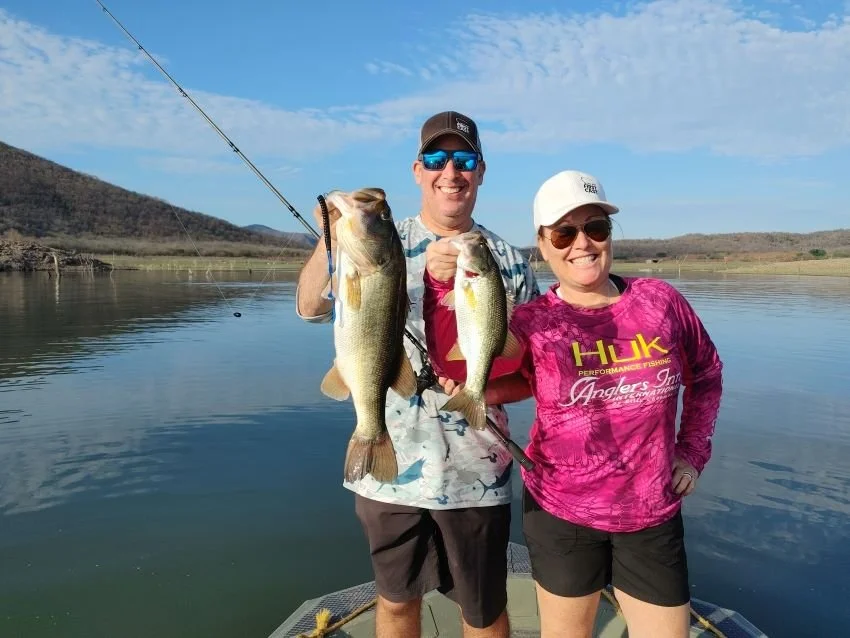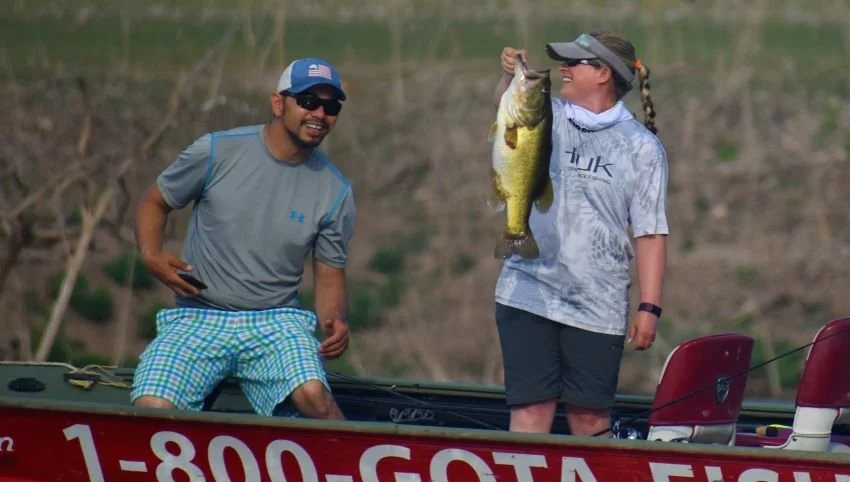How to Teach Your Spouse to Fish
I know plenty of male anglers who like to go on fishing trips specifically to be with the guys or to get away from their wives. If that dynamic works for your relationship, go for it, but I’ve always taken a different approach. If I could find a woman who loved to fish, or who could be convinced that she loved to fish, it would make for a stronger relationship – and more time on the water for both of us.
I’ve been fortunate in that regard. Hanna came into our partnership essentially never having fished, but she picked it up quickly. Now not only is she better than most guys, and certainly more well-traveled, but she has the bug. She wants to go, even on the rare occasions that I don’t.
It’s not always roses and unicorns, but for the most part it has worked out well. Along the way we’ve met numerous other couples with whom we fish. Since I’m not the most social individual, that helps our relationship too, since Hanna is an extrovert. Most importantly, when it comes time to plan a vacation, we’re usually headed someplace pretty amazing instead of to 90 year old Aunt Enid’s house in Akron to “visit.” Furthermore, there’s no questioning about the cost of certain lures or boats, since “what’s mine is mine and what’s hers is mine” (or something like that).
So if you think your spouse is malleable, or if your relationship won’t survive without her understanding your love of time on the water, follow the template below. There are no guarantees, but I think our marriage is proof of concept.
[Note: For the sake of simplicity, I am going to refer to the learning spouse as “her” below. I do recognize, however, that there are some ardent female anglers who’d like to teach their husbands or boyfriends to fish. Please don’t take offense.]
Treat Her Like a Kid (But Don’t Treat Her Like a Kid)
Many of the rules that apply to teaching a child to fish also apply to introducing your significant other to the sport: focus on them; go for limited periods of time; go when the fishing is likely to be good; don’t give them crappy equipment; make it fun (and bring snacks). But your husband or wife is not your child. There’s a completely different power dynamic, one more of equality (I assume) than elder/youngster. There’s also typically a lot of baggage in the relationship, some good, some bad. You’ll be surprised at how often this enters the subtext of any situation where there’s an inherent imbalance of power. When you start condescending to your spouse, it’s never good.
Get Someone Else to Help
Because fishing is assumedly important to you, and less a matter of life-and-death to her, you’re going to have trouble toning it down. The best way to teach someone is only to cast yourself when it is absolutely necessary for instructional purposes. Otherwise, you should mostly give up on fishing when you’re also teaching.
When Hanna and I first became a couple, I typically had one day a week to fish. I wanted her to get jacked up about the sport, but I also really wanted to set a few hooks. I gave her a spinning rod or two and let her do her own thing. That led to frustration. She saw me catching fish with baitcasting gear and wanted some of her own, but I knew that we’d be deep in backlash city. Fortunately, I enlisted the help of Potomac River guide Steve Chaconas. We went out in his boat on a Friday morning and I watched as he patiently taught her to competently use a baitcaster.
A similar situation ensued when I tried to teach her to pitch to boat docks and flooded bushes. Something was lost in translation – no matter how much I tried to show her, or explain it to her in different ways, she just couldn’t master it. Then, one day when we were fishing separately in Mexico, she asked her guide Juan for a brief primer, and while he didn’t turn her into Denny Brauer, the before and after was night-and-day.
Go Where You’ll Catch Fish
As with any newcomers, take her where she’ll catch fish, or at least have a reasonable chance of catching fish. Places not to take them on their first trip: casting for muskies; flyfishing for bonefish in a crosswind. I’d say someplace like Lake Picachos in Mexico, where you can expect to catch a hundred-plus a day, is ideal, except that there’s nothing else to do there except fish. If she’s already been indoctrinated a bit, that’s fine, but for a first day on the water you’re taking a risk going all that way and spending a not-insubstantial chunk of change. To the extent that the cliché holds true and the tug is the drug, they’re never going to get excited about it if no fish catches are registered.
Wait for the Right Conditions and Get the Right Clothing
You may love fishing in pre-frontal hurricane-grade winds, or not mind a driving rain, but for someone who’s still feeling their way around the basic mechanics, that’s not a good way to start. Wait for a day when the weather is temperate and there aren’t rollers crashing down on the back deck of the boat. It doesn’t have to be “Chamber of Commerce” weather, but it should be conducive to not wearing a hood so you can hear each other. No matter what, make sure that you have her dressed in the right clothing – sun protective, waterproof, warm enough, whatever the conditions call for. Again, you want those early impressions to be all positive. If they associate fishing with sunburn or shrinkage, that’s a hard association to break.
Get Her Some Equipment of Her Own
Part of being involved is having a stake in the outcome and a certain pride of ownership. Also, if your wife is constantly asking to grab the one cranking rod you love the most, or boogering up your reels, there’s going to be marital strife (we won’t talk here about the Power Tackle flipping stick that she “stole” from me a decade plus ago that I’d love to get back but can’t). Don’t go out and buy her a full set of top-of-the-line rods and reels until you’re sure she’s here to stay (both in the sport and in the marriage), but once she shows a little interest, it’s time to get some decent gear. Early in Hanna’s fishing career I did some work for a property that Skeet Reese owned, and traded out my writing for eight of those yellow rods that he endorsed. They immediately became hers (by design, unlike the flipping stick referenced above). They became part of her identity, and while I don’t know if I’d like them, I know that she’s made good use of them, both at home and in Mexico, where a few still reside. They’ve landed hundreds of fish, including multiple bass over 9 pounds.
Be Willing to Step Off the Gas
You might want to fish from “when you can until when you can’t,” for a week straight, through all kinds of weather. They might like or even love the sport, but not quite that much. Make sure you don’t burn them out. That defeats the purpose of the exercise.
Mistakes I’ve Made Along the Way
While the end result has been good, there were some speed bumps along the way. Looking back, I should have done more to get her involved in processes. In particular:
I Didn’t Explain the “Hows” and “Whys” — She’s been fortunate to go great places, fish with some pro anglers and top guides, and generally use high quality gear, but I probably should have explained more along the way, so she’d understand what we were doing and why it made a difference. The more you know, the more you want to know.
I Didn’t Require Her to Do More Herself — Hanna still has it easy – doesn’t spool up reels, buy tackle, take the boat to the mechanic – and that’s partially by design. I am sort of a control freak and like doing those things to ensure that they’re done a certain way. Nevertheless, I probably should have let her learn to do some of them, even if it meant occasional failure, to make her more invested and involved in the process.
I Didn’t Require Her to Run the Trolling Motor — She doesn’t like being in the back of the boat, but she also doesn’t want to have to think about running the foot-controlled electric. After nearly two decades, I keep telling her that after a single day it will no longer be a distraction. At some point I just have to force her to get it over with. On safety-related matters, however, I have been a stickler. She can (more or less) drive the boat and put it on the trailer, so if that becomes necessary due to emergency we’re covered.








